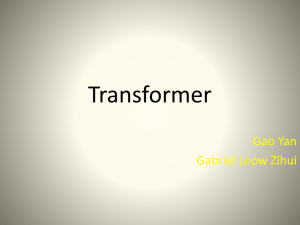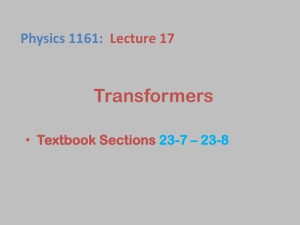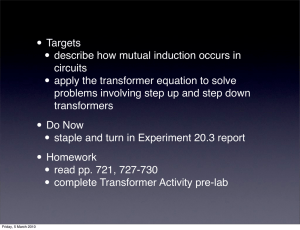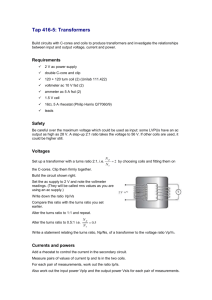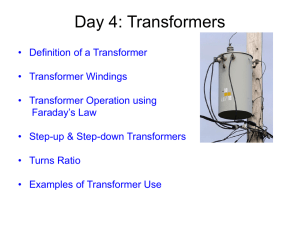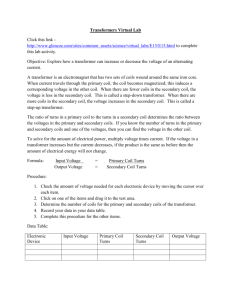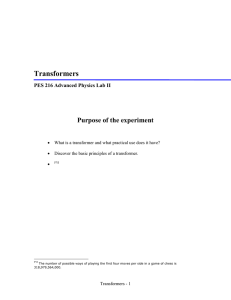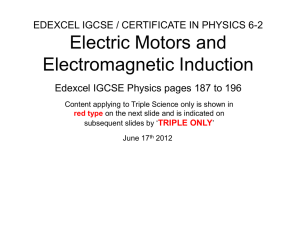Example 21-9
advertisement
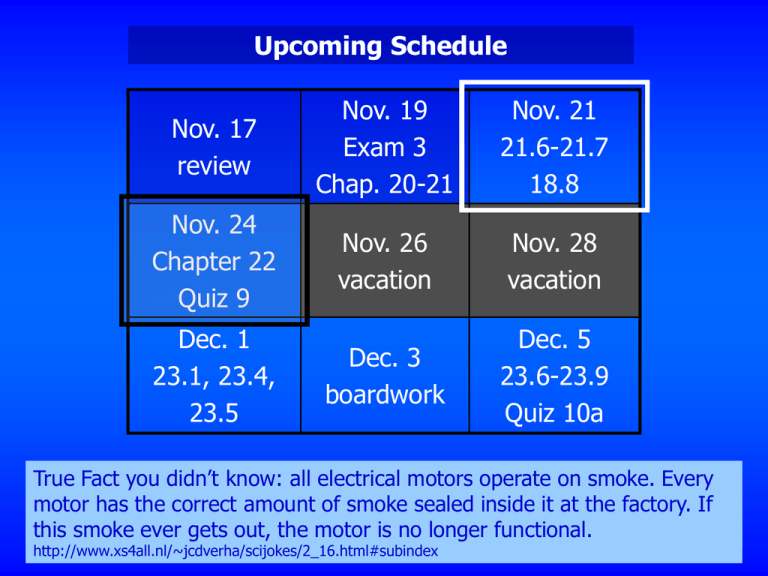
Upcoming Schedule Nov. 17 review Nov. 19 Exam 3 Chap. 20-21 Nov. 21 21.6-21.7 18.8 Nov. 24 Chapter 22 Quiz 9 Nov. 26 vacation Nov. 28 vacation Dec. 3 boardwork Dec. 5 23.6-23.9 Quiz 10a Dec. 1 23.1, 23.4, 23.5 True Fact you didn’t know: all electrical motors operate on smoke. Every motor has the correct amount of smoke sealed inside it at the factory. If this smoke ever gets out, the motor is no longer functional. http://www.xs4all.nl/~jcdverha/scijokes/2_16.html#subindex Exam 3 Average score = 184.8 (very high!). High score = 200. Nice job. End-of-semester quiz schedule is here. Let me explain it! Grades spreadsheet is here. Let’s look at it for a minute. Announcements page and Powerpoint lectures contain “official” announcements. Pdf versions of lectures are for your printing convenience, and may not contain the latest updates. A note on attendance policy. The syllabus says: “The lowest score of the four exams (3 semester, 1 final) will be dropped. However, you will not be allowed to drop the final exam unless you attend at least 2/3 of the scheduled class meetings after exam 3. If you attend less than 2/3 of the scheduled class meetings during that time, I will drop the lowest of the three in-semester exam scores.” This means exactly what it says. If you attend at least 2/3 of the final classes and skip the final exam, a “0” goes in your final exam score, and will be the dropped score. If you attend less than 2/3 of the final classes and skip the final exam, a “0” goes in your final exam score. The dropped score will be the lowest of your 3 exams. The “0” for the final will kill your grade! There are 8 class meetings after exam 3. You need to attend 5.4 of them to drop the final. Because 5.4 classes doesn’t make sense, I’ll count exam 3. You need to attend 6 of the 9 class meetings after (and including) exam 3. If you plan to take the final, you need to attend all classes! You “should” attend all classes because this is such wonderful stuff. (Actually, optics really is interesting and potentially useful.) Now for something completely off-topic… Ozark Christmas Castleman Hall, Saturday, December 13, 7:30 pm. Christmas bluegrass story dance Tickets: $10 adult, $5 student (including UMR), children free. Sponsored by Rolla Kiwanis Club; every penny goes to service projects in Rolla. “The Night Before Christmas” 21-6 Counter emf A changing magnetic field in wire produces a current. A constant magnetic field does not. In section 21.5 we saw how changing the magnetic field experienced by a coil of wire produces ac current. But the electrical current produces a magnetic field, which by Lenz’s law, opposes the change in flux which produced the current in the first place. http://campus.murraystate.edu/tsm/tsm118/Ch7/Ch7_4/Ch7_4.htm The effect is “like” that of friction. The counter emf is “like” friction that opposes the original change of current. Motors have many coils of wire, and thus generate a large counter emf when they are running. Good—keeps the motor from “running away.” Bad—”robs” you of energy. If your house lights dim when an appliance starts up, that’s because the appliance is drawing lots of current and not producing a counter emf. When the appliance reaches operating speed, the counter emf reduces the current flow and the lights “undim.” Motors have design speeds their engineers expect them to run at. If the motor runs at a lower speed, there is less-thanexpected counter emf, and the motor can draw more-thanexpected current. If a motor is jammed or overloaded and slows or stops, it can draw enough current to melt the windings and burn out. Or even burn up. 21-7 Transformers No, no, no… A transformer is a device for increasing or decreasing an ac voltage. Pole-mounted transformer Power Substation ac-dc converter A transformer is basically two coils of wire wrapped around each other, or wrapped around an iron core. When an ac voltage is applied to the primary coil, it induces an ac voltage in the secondary coil. A “step up” transformer increases the output voltage in the secondary coil; a “step down” transformer reduces it. The ac voltage in the primary coil causes a magnetic flux change given by ΔφB VP = NP . Δt The changing flux (which is efficiently “carried” in the transformer core) induces an ac voltage in the secondary coil given by ΔφB VS = NS . Δt Dividing the two equations gives the transformer equation OSE: VS NS = . VP NP For a step-up transformer, NS > NP and VS > VP (the voltage is stepped up). For a step-down transformer, NS < NP and VS < VP (the voltage is stepped down). Transformers only work with ac voltages; a dc voltage does not produce the necessary changing flux. A step-up transformer increases the voltage. Is this an example of “getting something for nothing?” No, because even though transformers are extremely efficient, some power (and therefore energy) is lost. If no power is lost, we can use P = IV to get OSE: IS NP = . IP NS flipped! If transformers only work on ac, how come you showed a picture of an ac-dc converter a few slides back? Ever wanted to cut open one of those ac-dc converters and see what they look like inside? An ac-dc converter first steps down the 120 volt line voltage, and then converts the voltage to dc: fewer turns in the secondary coil a diode is a device that lets current flow one way only (dc) Pictures of ac-dc converter came from http://www.howstuffworks.com/inside-transformer.htm Example 21-9 A transformer for home use of a portable radio reduces 120 V ac to 9 V dc. The secondary contains 30 turns and the radio draws 400 mA. Calculate (a) the number of turns in the primary; (b) the current in the primary; and (c) the power transformed. VS NS = VP NP VP NP = VS NS VP NP = NS VS 120 V NP = 30 turns 9 V NP = 400 turns IS NP = IP NS NS IP = IS NP NS IP = IS NP 30 turns IP = 0.400 A 400 turns IP = 0.030 A The power output to the secondary coil is PS = IS VS PS = 0.400 A 9 V PS = 3.6 W . This is the same as the power input to the primary coil because our transformer equation derivation assumed 100% efficient transformation of power. Example 21-10 An average of 120 kW of electrical power is sent to a small town from a power plant 10 km away. The transmission lines have a total resistance of 0.40 . Calculate the power loss if power is transmitted at (a) 240 V and (b) 24,000 V. This problem does not use the transformer equation, but it shows why transformers are useful. P = IV P I= V PLOST = I2 R 2 PLOST P = R V (a) at 240 V PLOST 120×10 W = 240 V 3 2 0.4 Ω PLOST = 100×103 W = 100 kW . (a) at 24000 V PLOST 120×10 W = 24000 V 3 2 0.4 Ω PLOST = 10 W . More than 80% of the power would be wasted if it were transmitted at 240 V, but less than 0.01 % is wasted if the power is transmitted at 24000 V. http://www.howstuffworks.com/power.htm

